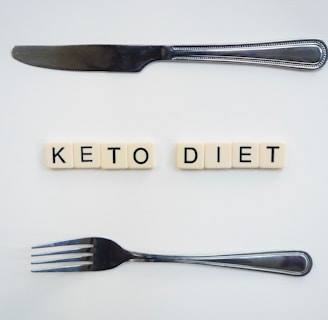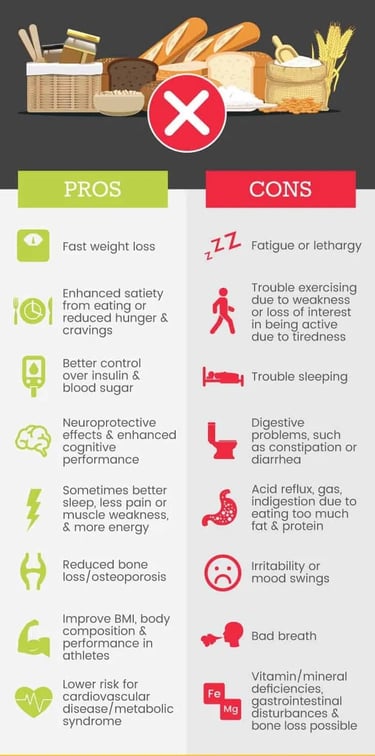The Ultimate Keto Guide: Unlock Your Body's Fat-Burning Potential
The ketogenic diet, or keto, has surged in popularity, promising rapid weight loss, improved energy levels, and enhanced mental clarity. But what exactly is keto, and how can you harness its power effectively? This comprehensive guide delves into the science, benefits, potential drawbacks, and practical tips for mastering the keto lifestyle.
DIET & NUTRITION


Understanding the Ketogenic Diet
At its core, the keto diet is a low-carbohydrate, high-fat, and moderate-protein eating plan. By drastically reducing carbohydrate intake, you force your body into a metabolic state called ketosis. In ketosis, your body shifts from primarily burning glucose (sugar) for energy to burning fat, producing ketones as an alternative fuel source.
The Macronutrient Breakdown (Keto Macros)
A typical keto macronutrient ratio looks like this:
70-80% Fat: This is the primary energy source. Focus on healthy fats like avocados, olive oil, nuts, seeds, and fatty fish.
20-25% Protein: Moderate protein intake is crucial for maintaining muscle mass. Choose lean meats, poultry, fish, and eggs.
5-10% Carbohydrates: This is the most restrictive aspect. Limit your carbohydrate intake to 20-50 grams per day, depending on your individual needs and activity level.
Entering Ketosis: The Metabolic Shift
When you significantly reduce carbohydrate intake, your body's glycogen (stored glucose) reserves deplete. This forces your liver to convert fat into ketones, which are then used as fuel by your brain, muscles, and other tissues. This metabolic shift, known as ketosis, is the hallmark of the ketogenic diet.
Benefits of the Keto Diet
The keto diet offers numerous potential health benefits, including:
Weight Loss (Keto for Weight Loss): By promoting fat burning and reducing appetite, keto can be highly effective for weight management.
Improved Blood Sugar Control: Keto can help regulate blood sugar levels, making it beneficial for individuals with type 2 diabetes or insulin resistance.
Enhanced Mental Clarity and Focus: Ketones are a clean and efficient fuel source for the brain, potentially leading to improved cognitive function.
Reduced Appetite and Cravings: The high-fat content of keto promotes satiety, helping to curb cravings and reduce overall calorie intake.
Potential Therapeutic Applications: Research suggests that keto may have therapeutic benefits for conditions like epilepsy, Alzheimer's disease, and certain types of cancer.
Keto Foods: What to Eat
Building a successful keto diet revolves around choosing the right foods. Here's a breakdown of keto-friendly options:
Healthy Fats: Avocados, olive oil, coconut oil, MCT oil, nuts (almonds, walnuts, macadamia), seeds (chia, flax), fatty fish (salmon, mackerel), and grass-fed butter.
Proteins: Beef, chicken, pork, lamb, fish, eggs, and shellfish.
Low-Carb Vegetables: Leafy greens (spinach, kale, lettuce), broccoli, cauliflower, zucchini, asparagus, and bell peppers.
Dairy (in moderation): Heavy cream, full-fat cheese, and unsweetened yogurt.
Avocado: This fruit is a keto staple, rich in healthy fats and fiber.
Foods to Avoid on Keto
Sugary Foods and Drinks: Soda, juice, candy, pastries, and desserts.
Grains: Bread, pasta, rice, cereals, and oats.
Starchy Vegetables: Potatoes, corn, peas, and sweet potatoes.
Fruits (high-carb): Bananas, grapes, mangoes, and apples (berries in moderation are acceptable).
Legumes: Beans, lentils, and chickpeas.
Processed Foods: Packaged snacks, fast food, and processed meats.
Creating a Keto Diet Plan (Keto Diet Plan)
A well-structured keto diet plan is essential for success. Here's a sample meal plan:
Breakfast: Eggs with avocado and spinach.
Lunch: Salad with grilled chicken or salmon, avocado, and olive oil dressing.
Dinner: Steak or fish with roasted broccoli and cauliflower.
Snacks: Nuts, cheese, or hard-boiled eggs.
Keto Recipes (Keto Recipes)
Explore a variety of delicious and satisfying keto recipes to keep your meals interesting and enjoyable. Search for keto specific websites, and recipe blogs.
Keto for Beginners (Keto for Beginners)
Starting keto can seem daunting, but with the right approach, it can be a smooth transition.
Educate Yourself: Understand the principles of keto and the importance of tracking macros.
Plan Your Meals: Create a meal plan for the week to ensure you have keto-friendly options readily available.
Stock Your Pantry: Fill your pantry with keto staples like healthy fats, proteins, and low-carb vegetables.
Stay Hydrated: Drink plenty of water to combat potential side effects.
Track Your Progress: Monitor your weight, energy levels, and ketone levels to gauge your progress.
Keto Side Effects (Keto Side Effects)
Some individuals may experience temporary side effects during the initial stages of keto, often referred to as the "keto flu."
Headaches: Caused by electrolyte imbalances.
Fatigue: Resulting from the body adapting to using fat for fuel.
Constipation: Due to reduced fiber intake.
Muscle Cramps: Caused by electrolyte deficiencies.
"Keto Breath": A fruity or metallic odor due to acetone production.
Managing Keto Side Effects
Increase Electrolyte Intake: Consume electrolyte-rich foods or supplements.
Stay Hydrated: Drink plenty of water and add electrolytes.
Increase Fiber Intake: Include low-carb, high-fiber vegetables in your diet.
Gradual Transition: Gradually reduce carbohydrate intake to minimize side effects.
Keto Supplements (Keto Supplements)
While not mandatory, certain supplements can support your keto journey.
Electrolytes: Sodium, potassium, and magnesium to prevent deficiencies.
MCT Oil: Provides a quick source of energy and can enhance ketone production.
Exogenous Ketones: Can help boost ketone levels and ease the transition into ketosis.
Digestive Enzymes: Can aid in the digestion of fats.
Keto for Women (Keto Diet for Women) and Men (Keto Diet for Men)
While the fundamental principles of keto remain the same, some considerations are specific to gender.
Women: Hormonal fluctuations can impact keto success. Pay attention to your cycle and adjust your diet accordingly.
Men: Keto can be effective for building muscle mass when combined with strength training. Ensure adequate protein intake.
Healthy Keto (Clean Keto) vs. Dirty Keto
Healthy Keto (Clean Keto): Focuses on whole, unprocessed foods, emphasizing nutrient density and quality.
Dirty Keto: Allows for processed foods and artificial ingredients, prioritizing macronutrient ratios over food quality. Healthy keto is the best long term approach.
Long-Term Sustainability
The long-term sustainability of keto depends on individual preferences and lifestyle factors. Focus on creating a balanced and enjoyable approach that fits your needs.
Consulting a Healthcare Professional
It's essential to consult with a healthcare professional or registered dietitian before starting any new diet, especially if you have underlying health conditions.
Conclusion
The ketogenic diet is a powerful tool for weight loss, improved health, and enhanced well-being. By understanding the principles of keto, choosing the right foods, and managing potential side effects, you can unlock your body's fat-burning potential and achieve your health goals. Remember to prioritize a healthy, sustainable approach and consult with a healthcare professional for personalized guidance.


